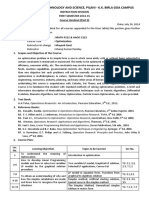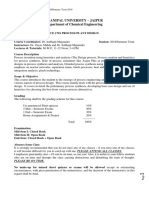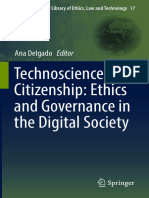Math F212 Opti
Math F212 Opti
Uploaded by
Shivam KediaCopyright:
Available Formats
Math F212 Opti
Math F212 Opti
Uploaded by
Shivam KediaOriginal Description:
Original Title
Copyright
Available Formats
Share this document
Did you find this document useful?
Is this content inappropriate?
Copyright:
Available Formats
Math F212 Opti
Math F212 Opti
Uploaded by
Shivam KediaCopyright:
Available Formats
FIRST SEMESTER 2021-2022
Course Handout Part II
Date: August 20, 2021
In addition to part-I (General Handout for all courses appended to the time table) this portion gives further
specific details regarding the course.
Course No. : MATH F212
Course Name : Optimization
Instructor-in-charge : P.T.V. Praveen Kumar,
Instructor : D. K. Satpathi, K. Venkataratnam, Sumit Kumar Vishwakarma
1. Scope and Objective of the Course:
Engineers, scientists, analysts, and managers are often faced with the challenge of making trade-offs
between different factors in order to achieve desirable outcomes. Optimization is the process of
choosing these trade-offs in the best way. Optimization problems, having reached a degree of
maturity over the past several years, are encountered in physical sciences, engineering, economics,
industry, planning, and many other areas of human activity. The objective of the course is set to
familiarize students with standard methods of solving optimization problems.
This course deals with details of various aspects associated with Optimization. These include a
description of optimization techniques, namely, Linear Programming and Nonlinear Programming,
and their applications to various engineering and science disciplines, including economics and
finance. Multi-objective Optimization, which handles optimization aspects of more than one
objective, is also discussed. A brief and informative description of Nontraditional optimization
techniques such as Genetic Algorithms, Differential Evolution, Memetic Algorithms, Ant Colony
Optimization, Particle Swarm Optimization, etc. is also provided.
2. Text Book:
T1 HA Taha, Operations Research: An Introduction, Pearson Education, 10/E, 2019.
Reference Books:
R1 SS Rao, Engineering Optimization: Theory and Practice, New Age International (P) Limited,
Third Edition, 1996
R2 FS Hillier and GJ Lieberman, Introduction to Operations Research, TMH, 8/E, 2006.
R3 WL Winston, Operations Research: Applications and Algorithms, Thomson Learning, 4th
Edition, 2004
R4 JC Pant, Introduction to Optimization: Operations Research, Jain Brothers, New, 6/E, 2004.
R5 A Ravindran, DT Philips and JJ Solberg, Operations Research: Principles and Practice, John
Wiley & Sons, Singapore, Second Edition, 1987
R6 GC Onwubolu and BV Babu, New Optimization Techniques in Engineering, Springer-Verlag,
Heidelberg, Germany, First Edition, 2004.
3. Course Plan:
Chapter in the
Lecture Nos. Learning Objectives Topics to be Covered
Text Book
Understand the concepts of
1 Optimization. Learn basic Introduction to Optimization
optimization techniques
Understand and develop Linear Two variable LP model, Graphical LP T1 (2.1, 2,2, 2.4,
2-4 Programming models for solution, Selected LP applications, Convex 7.1)
mathematical problems Set
5-6 Understand different techniques LP model in equation form, Transition from T1 (3.1, 7.1.1 ,
available for solving two, graphical to algebraic solution 3.2)
multivariate LP problems.
7-9 The Simplex Method Generalized simplex T1(3.3., 7.1.2,
tableau in matrix form, Revised Simplex 7.2)
Method.
10-12 Artificial starting solution T1(3.4, 3.5)
Special cases in the simplex method
13-14 Definition of Dual Problem, Duality, T1 (4.1, 7.4,4.2)
Primal-Dual Relationships.
Understand and solve special
cases in the LP problems,
15-16 Economic Interpretation of Duality, T1(4.3, 4.4)
introduce sensitivity analysis to
Additional simplex algorithms (Dual
re-evaluate a solution. Practical
Simplex Method, Generalized Simplex
application of LP for solving
Algorithm),
real time problems
T1(4.5)
17-19 Post optimal Analysis
20-22 Definition of transportation problem, The T1 (5.1, 5.3)
Understand special cases of transportation Algorithm,
simplex problems and its
procedures.
23 The Assignment Model T1(5.4)
24-25 Understand multiple objective Goal Programming Formulation T1 (8.1, 8.2)
optimization problems and develop
models for solving them
26-28 Understand Integer Programming Formulation of IP problem T1 (9.1, 9.2)
Problems and different techniques
for solving IPP Branch and Bound method for solving IPP
Cutting Plane method
29 Understand the difference Unconstrained problems, Convex and T1 (20.1)
between LPP and Nonlinear concave functions,
Programming Problems. Solve
Nonlinear Programming R1 (5.7)
30-31 Elimination Methods: Fibonacci Method
Problems
and Golden Section Method,
Gradient of a Function, Descent Methods: T1 (21.1.1)
32-33 Steepest Descent Method and Conjugate T1(21.1.2)
Gradient Method,
R1( 6.11,6.12)
Karush-Kuhn-Tucker (KKT) Conditions,
34-35 T1 (20.2.2)
36-38 Quadratic Programming, T1(21.2.2)
Introduce Evolutionary Drawbacks of the Classical Techniques,
Computation Techniques Introduction to Nontraditional Optimization
39-40 R6
Techniques (Genetic Algorithms,
Differential Evolution, etc.)
5. Evaluation Scheme:
Evaluation Duration Weightage Date & Time Nature of
Component Component
Quiz 1 30 Minutes 15% To be announced Open book
Mid Semester 90 Minutes 30% 16/10/2021 1.30 - 3.00PM Open book
Quiz 2 30 Minutes 15% To be announced Open book
End Semester 120 Minutes 40% 23/12 AN Open book
* The total marks of all the components taken together will be 200.
6. Notices: All notices about the course will be put on CMS.
7. Consultation Hour: To be announced in the class by the respective Instructors.
8. Make-up: Make up for the tests will normally be held in the following week. Make up will be Granted only in genuine
cases. Permission must be taken in advance except in extreme cases.
9. Academic Honesty and Integrity Policy: Academic honesty and integrity are to be maintained by all the students
throughout the semester and no type of academic dishonesty is acceptable.
You might also like
- CV7001 Part 1 NoteDocument267 pagesCV7001 Part 1 NoteasdasNo ratings yet
- Social Ecology - State of The Art and Future Prospects PDFDocument202 pagesSocial Ecology - State of The Art and Future Prospects PDFAmdal Indonesia Online100% (1)
- ME F344 HandoutDocument3 pagesME F344 Handoutrushil guptaNo ratings yet
- Handout OPTIMIZATION PDFDocument2 pagesHandout OPTIMIZATION PDFAnimesh ChoudharyNo ratings yet
- 7 ME F344 Engineering Optimization AKGuptaDocument2 pages7 ME F344 Engineering Optimization AKGuptaSrikar RenikindhiNo ratings yet
- Math F212 1122 PDFDocument3 pagesMath F212 1122 PDFAryaman MandhanaNo ratings yet
- CIF-Optimization Techniques and AppliationsDocument4 pagesCIF-Optimization Techniques and AppliationsSamarth MathurNo ratings yet
- OPTIDocument3 pagesOPTISARANSH AGARWALNo ratings yet
- Pilani Pilani Campus: Birla Institute of Techonology and ScienceDocument4 pagesPilani Pilani Campus: Birla Institute of Techonology and ScienceShlok SatyamNo ratings yet
- Birla Institute of Technology & Science, Pilani Course Handout Part A: Content DesignDocument8 pagesBirla Institute of Technology & Science, Pilani Course Handout Part A: Content DesignSunny KumarNo ratings yet
- Phy F313Document3 pagesPhy F313Ankit GoyalNo ratings yet
- 2.1 Communication Skills - IiDocument23 pages2.1 Communication Skills - IiArchNo ratings yet
- ME F320 Engineering OptimizationDocument5 pagesME F320 Engineering OptimizationARYAAN PARIDANo ratings yet
- 19MAT101 Single Variable Calculus - Lecture PlanDocument2 pages19MAT101 Single Variable Calculus - Lecture PlanRevanth PenmetsaNo ratings yet
- Daa SlyDocument4 pagesDaa SlySasi.b. KumarNo ratings yet
- Applied Mathematics - IDocument4 pagesApplied Mathematics - Iemailforthisipad123No ratings yet
- Daa Unit Wise QuesDocument18 pagesDaa Unit Wise QuesvijayarNo ratings yet
- Handout MATH F241 2 2024Document4 pagesHandout MATH F241 2 2024GAURISH TRIVEDINo ratings yet
- Teaching and Learning Plan (TLP) : S. P. Mandali'S Prin L. N. Welingkar Institute of Management Development & ResearchDocument4 pagesTeaching and Learning Plan (TLP) : S. P. Mandali'S Prin L. N. Welingkar Institute of Management Development & ResearchsiddheshNo ratings yet
- AdvcalcsyllDocument6 pagesAdvcalcsyllRadhaAnanthalekshmiNo ratings yet
- VMR Institute of Technology and Management Sciences: 9346009494. Website:, EmailDocument4 pagesVMR Institute of Technology and Management Sciences: 9346009494. Website:, Emailbanala_vinayNo ratings yet
- 2.1 Communication Skills - Ii: RationaleDocument24 pages2.1 Communication Skills - Ii: RationaleChetan GuliaNo ratings yet
- Course ObjectivesDocument4 pagesCourse ObjectivesSreekanth KuNo ratings yet
- Aaoczc 222Document3 pagesAaoczc 222aman_sasanNo ratings yet
- Course Handout Math-Ii (Ma 1004) PDFDocument4 pagesCourse Handout Math-Ii (Ma 1004) PDFAditi SrivastavaNo ratings yet
- CE G619-Finite Element Analysis (R) - PNRaoDocument3 pagesCE G619-Finite Element Analysis (R) - PNRaoMAGDUM SAMMED JINENDRANo ratings yet
- DSAD Regular HODocument6 pagesDSAD Regular HODavidNo ratings yet
- De ZG513 Course HandoutDocument8 pagesDe ZG513 Course HandoutpanyamnrNo ratings yet
- Che G558 2152 20230811120111Document3 pagesChe G558 2152 20230811120111JyotiNo ratings yet
- CS G526-HandoutDocument3 pagesCS G526-Handoutxedale7959No ratings yet
- MATH F241 - HandoutDocument3 pagesMATH F241 - HandoutOPM RockyNo ratings yet
- BE Comp 4th Sem Syallabus Compiled by U0 - 240422 - 115845 - RemovedDocument17 pagesBE Comp 4th Sem Syallabus Compiled by U0 - 240422 - 115845 - Removedanjalluitel3No ratings yet
- Artificial Neural Network ApproachDocument22 pagesArtificial Neural Network ApproachMuhammad Sabeel KhanNo ratings yet
- ACFrOgDn4OIKAIJbNvjomZ-PFD mScC817utCcxl9GNXo s4YUIPCF1yiygplghaW OdWCAZC6obUBvEw2dRCS0GUVZ-oeHdeAcr70fDQznl3Q3IaEPZGV XMj7jgkwFwvg9 zfS5zICLq7Op5N1Document5 pagesACFrOgDn4OIKAIJbNvjomZ-PFD mScC817utCcxl9GNXo s4YUIPCF1yiygplghaW OdWCAZC6obUBvEw2dRCS0GUVZ-oeHdeAcr70fDQznl3Q3IaEPZGV XMj7jgkwFwvg9 zfS5zICLq7Op5N1Sunil DasNo ratings yet
- Daa Cif 2024Document5 pagesDaa Cif 202423ucs649No ratings yet
- 1) Lao - Wase Wims HoDocument6 pages1) Lao - Wase Wims HoV JalandharNo ratings yet
- Dsad HoDocument6 pagesDsad Hohoxarec699No ratings yet
- Handout MATH F212Document2 pagesHandout MATH F212bits_who_am_iNo ratings yet
- ChE F242 Numerical Methods For Chemical Engineers Semester II 2023-2024Document6 pagesChE F242 Numerical Methods For Chemical Engineers Semester II 2023-2024AzureNo ratings yet
- Course Plan CM Cie 3153 - 2020 (3 Credit)Document5 pagesCourse Plan CM Cie 3153 - 2020 (3 Credit)Don KarthikeyaNo ratings yet
- Wa0008.Document4 pagesWa0008.Monika SNo ratings yet
- SS ZC416 Revised Course HandoutDocument6 pagesSS ZC416 Revised Course HandoutMohit SidhwaniNo ratings yet
- Additional Mathematics-II (: 18MATDIP41)Document2 pagesAdditional Mathematics-II (: 18MATDIP41)balajiNo ratings yet
- DSE 2155 DS Course Plan August 2022Document5 pagesDSE 2155 DS Course Plan August 2022Aditya PatelNo ratings yet
- Course Objectives:: Make Use of Determinants and Matrices in Finding The Solutions of A Linear SystemDocument4 pagesCourse Objectives:: Make Use of Determinants and Matrices in Finding The Solutions of A Linear SystemBARAZIL SERVERNo ratings yet
- Management Science Course Guide BookDocument17 pagesManagement Science Course Guide BookSleshi MekonnenNo ratings yet
- OptimizationDocument2 pagesOptimizationsiddhardha9010No ratings yet
- Birla Institute of Technology & Science, Pilani Course Handout Part A: Content DesignDocument6 pagesBirla Institute of Technology & Science, Pilani Course Handout Part A: Content DesignShreyansh AnshumanNo ratings yet
- MATH F212 HandoutDocument3 pagesMATH F212 HandoutTarun KumarNo ratings yet
- Optimization Handout AAOC222 Sem1 2012 13Document3 pagesOptimization Handout AAOC222 Sem1 2012 13Kartikeya BhardwajNo ratings yet
- Taylor Series Based Numerical Integration MethodDocument10 pagesTaylor Series Based Numerical Integration MethodSamir HamdiNo ratings yet
- Calculus SyllabusDocument4 pagesCalculus Syllabusnirvesh8269No ratings yet
- Optimization of Chemical ProcessesDocument2 pagesOptimization of Chemical ProcessesAmol RastogiNo ratings yet
- Course Handout For Process Plant DesignDocument4 pagesCourse Handout For Process Plant DesignOayes MiddaNo ratings yet
- DIGITAL IMAGE PROCESSING Course Information Sheet DIP-CS457-UITDocument4 pagesDIGITAL IMAGE PROCESSING Course Information Sheet DIP-CS457-UITMuhib U RehmanNo ratings yet
- NonneedDocument8 pagesNonneedArun DominicNo ratings yet
- 19me21p1 PDFDocument2 pages19me21p1 PDFbhargavramudu 2019No ratings yet
- Transform Calculus, Fourier Series and Numerical Techniques (Document3 pagesTransform Calculus, Fourier Series and Numerical Techniques (DannydonNo ratings yet
- Cho 22ai011otDocument8 pagesCho 22ai011otdishu.diwanshiNo ratings yet
- Linear Programming: An Introduction to Finite Improvement Algorithms: Second EditionFrom EverandLinear Programming: An Introduction to Finite Improvement Algorithms: Second EditionRating: 5 out of 5 stars5/5 (2)
- Emotional Intelligence and Self-Esteem in Regular Elementary School Adolescents, A Post-Pandemic ResearchDocument12 pagesEmotional Intelligence and Self-Esteem in Regular Elementary School Adolescents, A Post-Pandemic Researchsebastiancosmelapierre1999No ratings yet
- Forecasting Hong Kong Hang Seng Index Stock Price Movement Using Social Media Data AnalysisDocument111 pagesForecasting Hong Kong Hang Seng Index Stock Price Movement Using Social Media Data AnalysisW.T LAUNo ratings yet
- Cap 1 Oslo Manual 2018Document17 pagesCap 1 Oslo Manual 2018Cristina SaldanhaNo ratings yet
- UNETHICALDocument12 pagesUNETHICALalyssa babylaiNo ratings yet
- The Family Wealth S.W.O.T: "We Stands For Wealth Enterprise."Document2 pagesThe Family Wealth S.W.O.T: "We Stands For Wealth Enterprise."Yusuff QuadrilateralNo ratings yet
- Sta404 Tuto Chap 1Document6 pagesSta404 Tuto Chap 1AyunieazahaNo ratings yet
- Embattled Identities Jaime Holthuysen 2011Document302 pagesEmbattled Identities Jaime Holthuysen 2011Bullet to DodgeNo ratings yet
- To Study Impulsive Buying Behavior of The Customers in Mumbai For The Financial Year 2016-17Document18 pagesTo Study Impulsive Buying Behavior of The Customers in Mumbai For The Financial Year 2016-17shivani sharmaNo ratings yet
- CDB 3033 Transport Phenomena: Course Administration & Outcome Based Education (OBE)Document8 pagesCDB 3033 Transport Phenomena: Course Administration & Outcome Based Education (OBE)FrendNo ratings yet
- IG 2009 A Study of Land ReclamationDocument25 pagesIG 2009 A Study of Land ReclamationFatimah Mohd Isa100% (2)
- Assignment 2 Professional PortfolioDocument3 pagesAssignment 2 Professional Portfolioapi-319339803No ratings yet
- Local Stress Concentrations in Imperfect Filamentary Composite MaterialsDocument18 pagesLocal Stress Concentrations in Imperfect Filamentary Composite Materialsn_kosmasNo ratings yet
- Bella Healthcare IndiaDocument14 pagesBella Healthcare Indiasrishti bhatejaNo ratings yet
- Measures of Relative StandingDocument59 pagesMeasures of Relative StandingGracean MaslogNo ratings yet
- GGP Curriculum Design and DeliveryDocument62 pagesGGP Curriculum Design and DeliveryStar CruiseNo ratings yet
- 4 - Eoi - Land Use Plan Lusaka Airport City, Livingstone Hotel, Mfuwe HotelDocument36 pages4 - Eoi - Land Use Plan Lusaka Airport City, Livingstone Hotel, Mfuwe Hotelnkhatamuchondi03No ratings yet
- NNF CPGDocument314 pagesNNF CPGManju KumariNo ratings yet
- Thematic AnalysisDocument9 pagesThematic AnalysisLeoNo ratings yet
- Basic Concepts of Health PlanningDocument35 pagesBasic Concepts of Health PlanningLlover Cameros YapNo ratings yet
- GenAI BrochureDocument4 pagesGenAI Brochureajay.aiwcheadofficeNo ratings yet
- Strand & Funtowicz Springer2017Document14 pagesStrand & Funtowicz Springer2017Roger StrandNo ratings yet
- Sociological TheoriesDocument46 pagesSociological TheoriesCeasar Estrada100% (1)
- Managing For Quality and ProductivityDocument12 pagesManaging For Quality and ProductivityJamil Kamara100% (1)
- Top Cited Articles in Signal & Image Processing 2021-2022Document7 pagesTop Cited Articles in Signal & Image Processing 2021-2022sipijNo ratings yet
- Fpsyg 15 1359164Document16 pagesFpsyg 15 1359164Iqra ChuhanNo ratings yet
- Project Development ManagerDocument1 pageProject Development ManageryasserosmanNo ratings yet
- ICAR Telephone Directory (33 55)Document202 pagesICAR Telephone Directory (33 55)vikas2354_268878339100% (1)
- Soi Form (Updated)Document13 pagesSoi Form (Updated)jadonciapparaNo ratings yet
- BMB&M Project For Reference ONLYDocument69 pagesBMB&M Project For Reference ONLYDuy AnhNo ratings yet

























































































